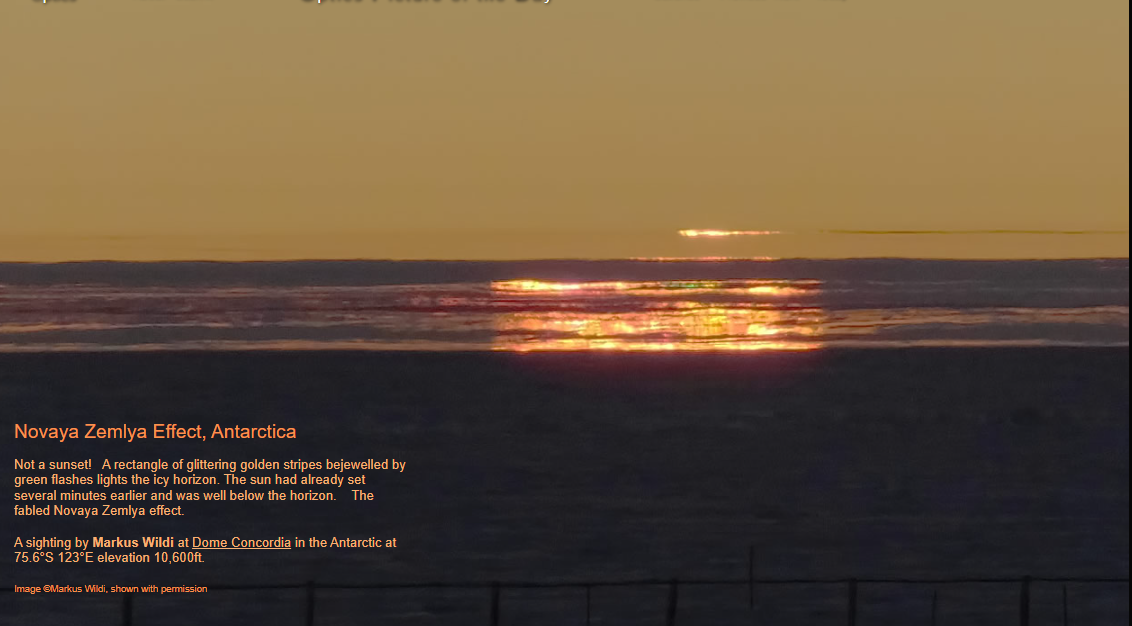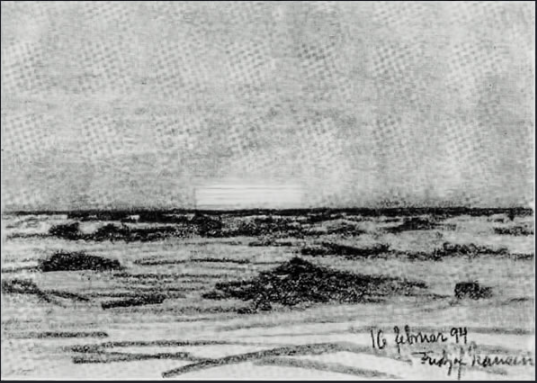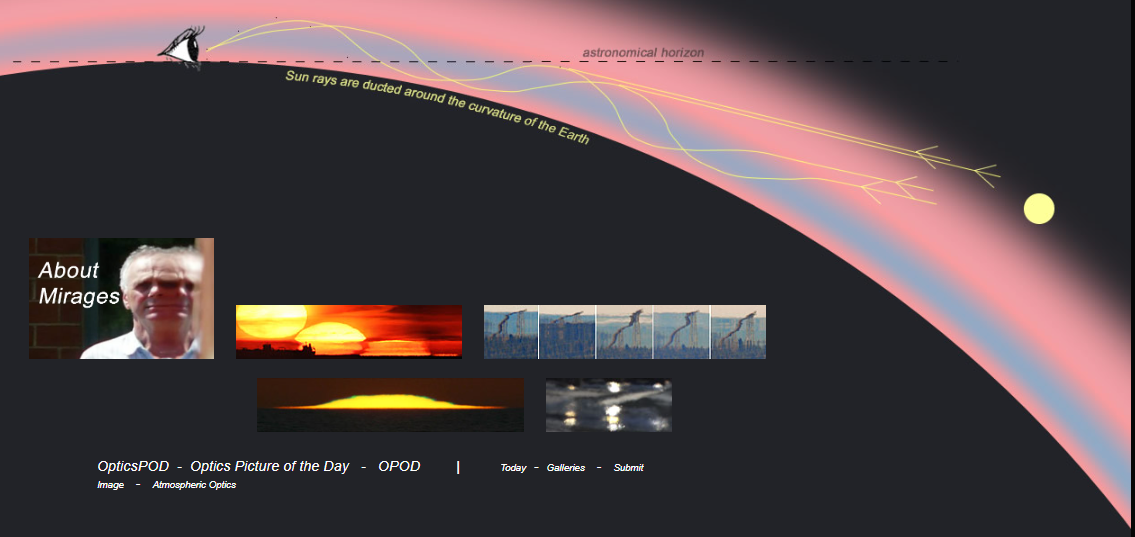Novaya Zemlya Effect - OPOD
The Novaya Zemlya Effect: A Fascinating Atmospheric Phenomenon
The Novaya Zemlya Effect, also known as the NZ effect, is a mesmerizing atmospheric phenomenon that creates the illusion of a rectangular shape of golden stripes adorned with green flashes on the horizon. This captivating sight occurs when the sun has already set and is well below the horizon. The effect was first recorded in 1597 during one of Barentz' Arctic expeditions and has since been observed in various polar regions, including Antarctica.
A Unique Observation
One notable sighting of the Novaya Zemlya Effect took place at Dome Concordia in Antarctica by Markus Wildi. At an elevation of 10,600 feet and coordinates 75.6°S 123°E, Wildi witnessed the spectacle of a rectangle of glittering golden stripes illuminated by green flashes on the icy horizon. This remarkable observation demonstrates the elusive nature of this phenomenon and the awe-inspiring beauty it possesses.
Historical Accounts
Fridtjof Nansen, a renowned Arctic explorer, also documented his encounter with the Novaya Zemlya Effect during his expedition on the ship 'Fram' in 1894. Nansen described seeing a mirage resembling flattened-out glowing red streaks of fire on the horizon. He observed multiple streaks, one above the other, with dark spaces in between. From the main-top of his ship, Nansen witnessed four or even five horizontal lines stacked directly on top of each other, creating an image reminiscent of a square dull-red sun with dark streaks across it.
Understanding the Phenomenon
The Novaya Zemlya Effect is primarily caused by abnormal atmospheric refraction and miraging. In polar regions, where severe air temperature gradients exist above the ice surface, the conditions are ripe for this mirage to occur. A temperature inversion layer, with colder air below a relatively warmer layer, plays a crucial role in creating the necessary environment for the NZ effect.
The Role of Refraction
When rays from the sun enter the cold layer of air, they can be channeled or ducted around the curvature of the Earth for distances of up to a few hundred kilometers. As the rays pass from the cold air into the warmer air, they are refracted back towards the colder medium. If the refraction is strong enough, the rays bounce up and down inside the duct, creating multiple oscillating paths. An observer located at the other end of the duct will perceive a slot-shaped image of the sun below the horizon, transmitted over vast distances. This phenomenon gives rise to the characteristic stacked lines with blackness between them, ultimately forming a rectangular shape when fully developed.
Variations of the Novaya Zemlya Effect
While polar conditions or a lower warmer air layer are typically required for the Novaya Zemlya Effect to occur, variations of this phenomenon have been observed in other regions as well. For example, off the Californian coast, where strong inversions result from a combination of cold offshore sea currents and warm air from the land, NZ-like mirages have been seen. These mirages often manifest as mock-mirages, presenting three or more segmented suns.
The Enigmatic Nature of the Novaya Zemlya Effect
The Novaya Zemlya Effect continues to captivate scientists and enthusiasts alike due to its perplexing nature. The precise conditions necessary for this atmospheric phenomenon to occur are still not fully understood. However, it is clear that temperature inversions and strong atmospheric refraction play key roles in creating the illusion of a rectangular sun on the horizon.
In conclusion, the Novaya Zemlya Effect stands as a testament to the wonders of our atmosphere. Its ethereal beauty and enigmatic nature make it a subject of fascination for those who have been fortunate enough to witness this extraordinary optical phenomenon. As our understanding of atmospheric optics advances, we continue to unravel the secrets behind this captivating spectacle, allowing us to appreciate the breathtaking phenomena that occur in the world around us.

Novaya Zemlya Effect, Antarctica
Not a sunset! A rectangle of glittering golden stripes bejewelled by green flashes lights the icy horizon. The sun had already set several minutes earlier and was well below the horizon. The fabled Novaya Zemlya effect.
A sighting by Markus Wildi at Dome Concordia in the Antarctic at 75.6°S 123°E elevation 10,600ft.
Image ©Markus Wildi, shown with permission

A Novaya Zemlya effect sketched by the famous Arctic explorer, Fridtjof Nansen, on 16th February 1894. He had deliberately set his tiny ship 'Fram' into the ice to drift with it across the Arctic and hopefully to near the North Pole.
"The mirage was at first like a flattened-out glowing red streak of fire on the horizon; later there were two streaks, one above the other, with a dark space between; and from the main-top I could see four, or even five such horizontal lines directly over one another, and all of equal length; as if one could only imagine a square dull-red sun with horizontal dark streaks across it. An astronomical observation we took in the afternoon showed that the sun must in reality have been 2° 22' below the horizon at noon; we cannot expect to see its disk above the ice before Tuesday at the earliest; it depends on the refraction, which is very strong in this cold air. "
From 'Farthest North', F Nansen 1897.
The sun suddenly appears during the long Polar winter several days before it is expected to first show itself in spring. Or, later on, sunrises are unusually early and sunsets late. The "sun" is a flickering rectangular stack of thin pancakes spaced by darkness.
The effect was first recorded in 1597 during one of Barentz’ Arctic expeditions. The ship was beset in ice and the crew wintered on Novaya Zemlya (New Land/Earth). A ‘sunrise’ was seen on January 14th two weeks earlier than calculated and when the sun was actually 4.9° below the horizon. Later, Nansen (account at right) saw it. Ernest Shackleton observed it in Antarctica during his 1914-17 expedition that ended with one of the world’s greatest sea voyages to South Georgia.
Abnormal atmospheric refraction and miraging are responsible. Under Polar conditions, severe air temperature gradients can exist above the ice surface. When there is a strong temperature inversion layer – colder air below a relatively warmer layer – we have the conditions for a Novaya Zemlya (NZ) mirage.
Rays from the sun can enter the cold layer (see below). Once there they can be channelled (ducted) around the curvature of the Earth for distances up to a few hundred kilometres. A ray passing from cold air into warmer air is always refracted back towards the colder medium. If the refraction is strong enough the ray mirrors up and down inside the duct. An observer at the other end sees a slot shaped image of the below horizon sun transmitted hundreds of miles. A bit like a terrestrial star gate! Several oscillating paths are possible giving the characteristic stacked lines with blackness between. In the fully developed NZ effect each slot shaped image is a squashed full width whole sun thus giving, in total, a rectangular shape.
Polar conditions or the lower warmer air layer are not always necessary and NZs are sometimes seen off the Californian coast where strong inversions result from the combination of cold offshore sea currents and warm air from the land. A weaker form of the NZ is the more familiar mock-mirage of three or more segmented suns.
Thanks to Andrew Young for valuable discussions.

Note: this article has been automatically converted from the old site and may not appear as intended. You can find the original article here.
Reference Atmospheric Optics
If you use any of the definitions, information, or data presented on Atmospheric Optics, please copy the link or reference below to properly credit us as the reference source. Thank you!
-
<a href="https://atoptics.co.uk/blog/novaya-zemlya-effect-opod/">Novaya Zemlya Effect - OPOD</a>
-
"Novaya Zemlya Effect - OPOD". Atmospheric Optics. Accessed on April 24, 2024. https://atoptics.co.uk/blog/novaya-zemlya-effect-opod/.
-
"Novaya Zemlya Effect - OPOD". Atmospheric Optics, https://atoptics.co.uk/blog/novaya-zemlya-effect-opod/. Accessed 24 April, 2024
-
Novaya Zemlya Effect - OPOD. Atmospheric Optics. Retrieved from https://atoptics.co.uk/blog/novaya-zemlya-effect-opod/.